
Felipa Mayo cooks tacos each weekend outside her home on Compton Boulevard. Scroll down for a photo slideshow featuring other street cooks and street foods. | Daina Beth Solomon
Felipa Mayo starts her job the same way each weekend. She heads out to the sidewalk of her stucco bungalow on Compton Boulevard and checks to make sure there are no cops around.
Then she pulls a white toque over her brown hair bun, sets up a few folding tables in the driveway and unpacks the contraband she’s so worried about getting busted for selling: Tacos.
The corn tortillas served with chicken, beef or goat could get Mayo in trouble with the law.
The hundred other weekend vendors on this bustling stretch of Compton Boulevard in South Los Angeles -– some selling quesadillas, burritos and pupusas, others hawking merchandise ranging from electronics to underwear – operate with caution too.Every once in a while, city inspectors show up to clear the streets and confiscate equipment and goods. It’s happened to Mayo, a mother of five from Mexico who is studying culinary arts at L.A. Trade-Technical College. She’s just grateful she wasn’t slapped with a hefty fine as well.
Sidewalk vending in the city of L.A. is illegal. Now, after several years of advocacy efforts by more than 40 organizations, new regulations are on the horizon that will protect vendors from being penalized with fines or having to risk the loss of their cooking equipment, food and merchandise.
Changes from City Hall to the street
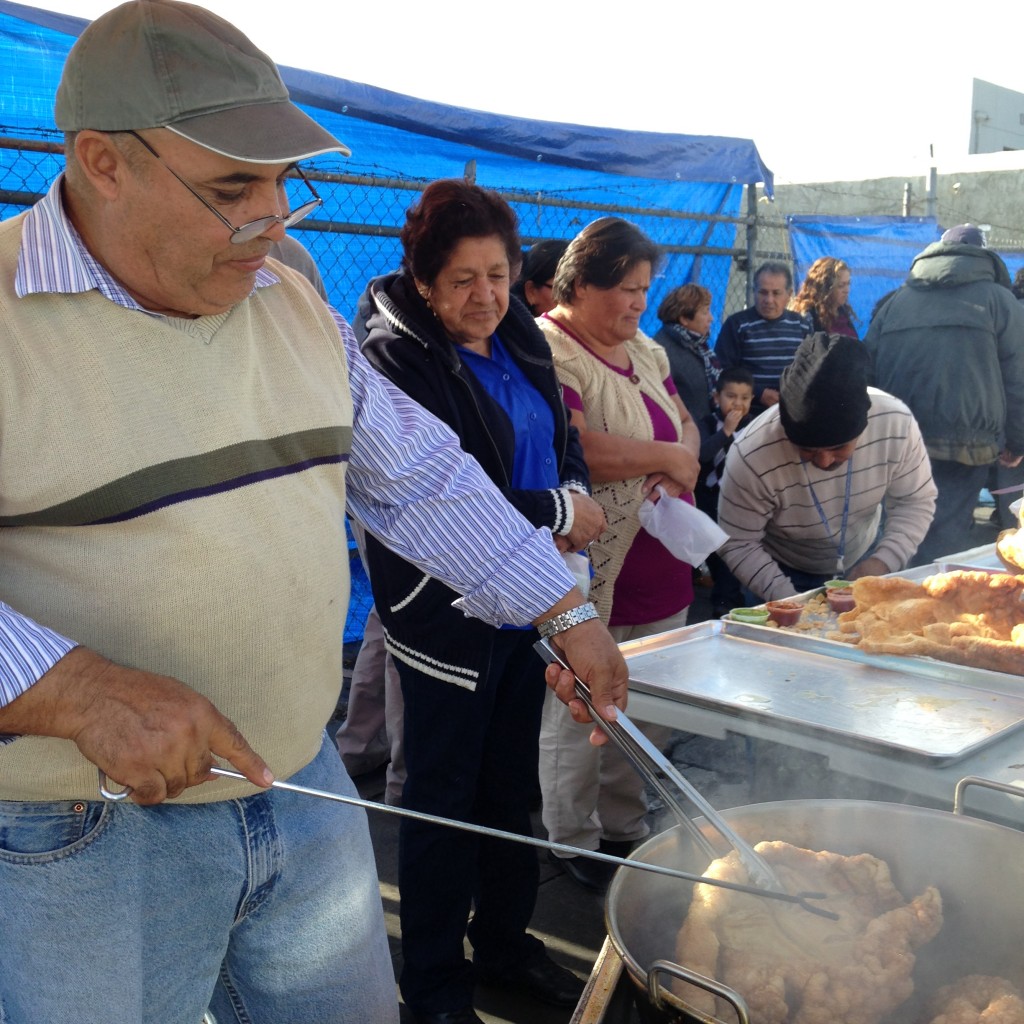
Enrique Peralta fries pork skin into chicharron at the Mercado Olympic each weekend. | Daina Beth Solomon
Councilmen Jose Huizar and Curren Price say the City Council will consider a proposal to legalize street vending in the next month or so. Jointly, these two councilmen called for studies and recommendations last November after City Council unanimously passed a motion to create the new ordinance.
“It’s a huge market and a primary source of income for many people, yet they have to constantly look over their shoulder for fear of receiving a citation,” said Price, who represents a large swath of South L.A.
Huizar, who represents Downtown and parts of north and East L.A., said legalization could lighten that burden for vendors.
“They can come out of the shadows and earn an honest living without fear,” he said.
Sellers like Enrique Peralta, who fries pork skin into crunchy pieces of chicharron at Mercado Olympic, a stretch of Olympic Boulevard in downtown’s industrial district, said he and his fellow entrepreneurs are tired of being treated like criminals.
“I don’t sell drugs, I don’t rob… I am working,” Peralta said in Spanish.
Mac Anthony Camacho, a taco seller, said selling food keeps people away from crime. His eight siblings sold tacos growing up in Guadalajara, Mexico, and continued to sell tacos when they came to the U.S. as teenagers. Now he and his brother Israel “El Peke” Villada sell about 1,200 each weekend, grossing roughly $1,800.
Sellers said they are particularly tired of monthly enforcement sweeps. The city’s Bureau of Street Services issues tickets for violating the municipal code, while the county’s Street Vending Program confiscates equipment from sellers without health permits.
In the past two years, Peralta, the chicharron vendor, said he has been fined twice, amounting to about $300 and $600, and has had his equipment, worth roughly $200, confiscated by authorities four times. He would prefer to buy a permit.
The East L.A. Community Corporation, which has pushed for new permitting rules, estimates that sellers earn between $15,000 and $30,000 annually.
“With pleasure I’ll pay,” said Peralta, who came to the U.S. from Toluca outside of Mexico City almost 25 years ago and now lives near the Coliseum. “But let me work.”
Guadalupe Ordaz, a fellow Mexican immigrant who stopped by Peralta’s stand to buy chicharrones, said she could relate.
“It’s quite difficult if you leave your family, and then they don’t let you work in peace,” she said in Spanish.
Latin American tradition turned foodie obsession
Many Latin American immigrants in L.A. depend on street vending for survival.
“It’s a way for somebody who may or may not have papers to come to the United States and start their own little business,” said Sarah Portnoy, a Latino culture scholar at the University of Southern California. “It’s entrepreneurial spirit based on necessity.”
In Latin America, street food is “pervasive,” said Portnoy, and immigrants have transported their culinary traditions to Los Angeles.
“Street food is now a part of our culture too,” she said.
These days, street food festivals take place throughout the year in Los Angeles.
Gourmet chefs invite street cooks into their kitchens, like the “Baja Chef Series” at high-end Playa where John Sedlar Rivera handed over the reigns to Tijuana taco vendors and charged guests $5 to $18 a plate.
And acclaimed chef Susan Feniger of the “Too Hot Tamales” television cooking show named her trendy Hollywood restaurant “Street,” an homage to her favorite curbside snacks from around the world.
Meanwhile Angelenos go into a frenzy tracking down their favorite street stands and write passionate reviews on Yelp and Chowhound.
One Chowhounder, calling himself “Das Ubergeek,” wrote about an East L.A. street:
“Picture it: open-air carts under bare bulbs where men and women chop meat and fashion dough into breads. Savoury steam escapes from mostly-covered pots kept warm on flat-top griddles. Children run around playing games and there’s a quiet roar of banter and joking, punctuated by sounds of ‘mmm!’ and ‘ah!’”
A man giving his name as John B. lauded the sauce-soaked enchiladas from a South L.A. vendor on Yelp, writing,
“These babies are awesome. Hand pressed tortillas, good meat, lots of toppings and friendly service. That and they’re the only enchiladas ahogadas street vendor that I’ve ever seen.”
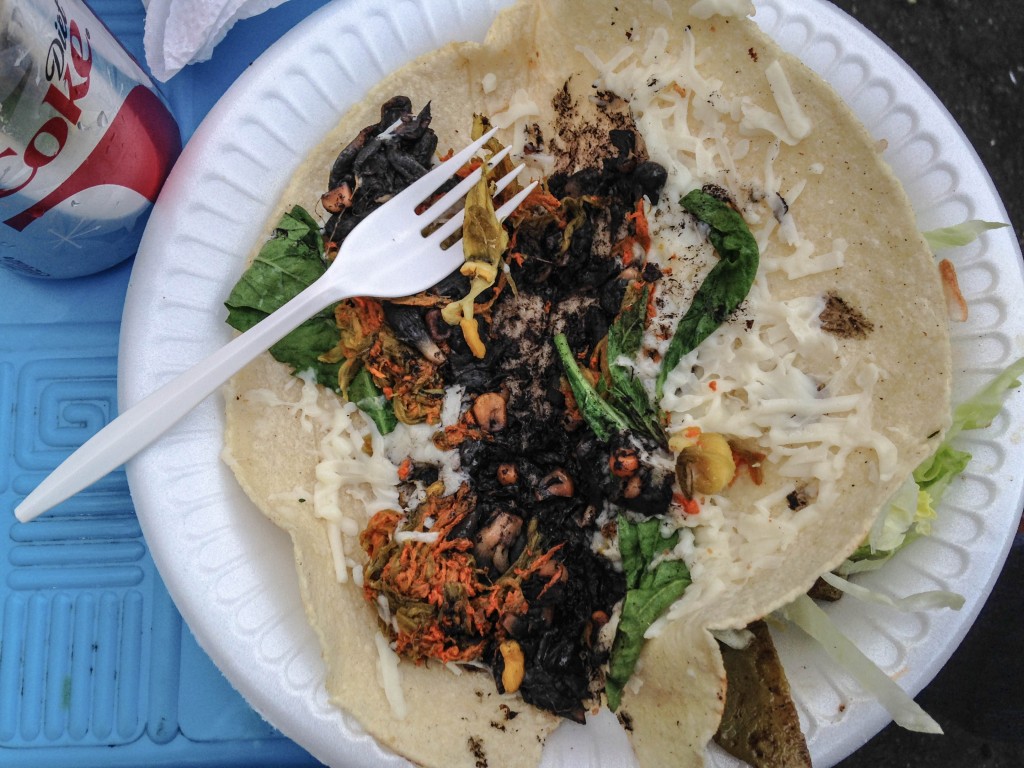
A quesadilla from Mercado Olympic cooked with huitlacoche, a delicate corn fungus, and quash blossom. | Daina Beth Solomon
Food critics, for their part, praise parking lot fare as if it were pricey gourmet cuisine – and some argue that despite the low prices, indeed it is, as Pulitzer Prize winning food critic Jonathan Gold wrote for Saveur magazine in 2010.
Not long after starting to write about food in the ’80s, Gold discovered he was “just as likely to find bliss on a folding table in a dicey parking lot as…in a Michelin-starred restaurant.”
Meanwhile, L.A. embraces immigrants more than it did in the ’70s and ’80s when immigrant-run street vending first boomed.
The population is nearly half Latino. Immigrants comprise 35 percent of L.A. County, and one out of 10 entered the U.S. without proper documentation. The last mayor grew up in a Mexican American family and the current mayor speaks Spanish. Huizar grew up in the Boyle Heights but was born in Mexico.
Trying to stop the illegal trade of food and other merchandise is futile, said Bill Esparza, a blogger who has gotten more than a million page views on his site Street Gourmet L.A.
“You can shut down the Mercado Olympic, but the vendors will just scatter to other neighborhoods,” he said.
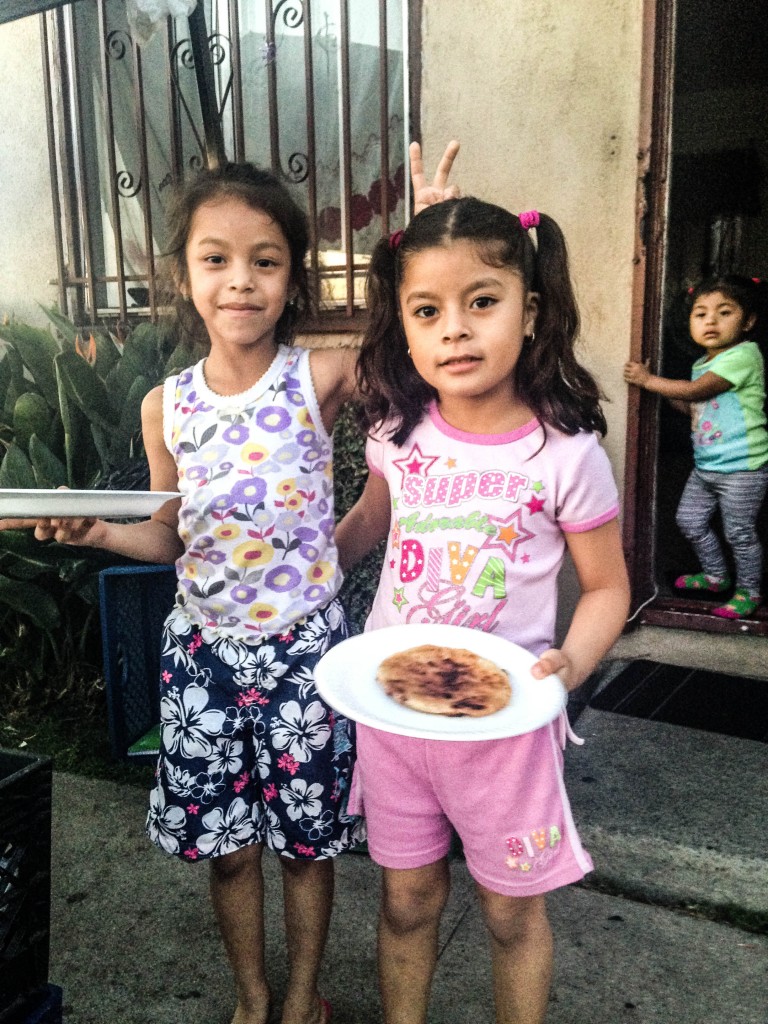
Girls stand outside their house in South LA where their family cooks and sells pupusas at an outdoor stand. | Daina Beth Solomon
Twenty years ago, a first — and last — try at legalizing a zone around MacArthur Park failed. The vendors, who collaborated with Mama’s Hot Tamales restaurant, faced too many limitations, and enforcement of those who refused to comply with the new rules was too sparse.
Shutting down illicit taco stands just isn’t a police priority.
And even if the Los Angeles Police Department wanted to crack down on vendors, said sergeant Ike Ornelas of South L.A.’s Newton Division, its resources are too few.
“Say we try to cite ’em, we have to get evidence,” said Ornelas, who has found ice-filled bathtubs like makeshift coolers stocked with hot dogs at more than one South L.A. vendor’s home. “I’m not going to take six of my officers to spend a few hours talking to people, gathering evidence, and doing paperwork.”
A permitting program this time around needs to be attractive to sellers, said Esparza.
“It has to be priced fairly, based on what they’re able to make,” he said. “You can’t set this bar so high like a restaurant, or even a food truck.”
Regulating an underground market could help influence it for the better, said Mark Vallianatos of Occidental College’s Urban and Environmental Policy Institute. The institute says legalization could encourage healthy food sales in areas such as South L.A. that have fewer fresh food markets than more affluent neighborhoods.
South L.A. has one grocery store per 22,156 people, according to the institute’s research, while the more affluent West L.A. has one store per 11,150 people. And while South L.A.’s streets are packed with all sorts of food shops, more than 70 percent are liquor and convenience stores with dismal-looking — and expensive — fruits and veggies. Similarly, 70 percent of South L.A.’s restaurants are greasy fast food chains and eateries. All this has led some to describe South L.A. as not a “food desert,” the term recently made popular in urban planning circles, but rather a “food swamp.”
Meanwhile, South L.A. bears the highest poverty and obesity rates in the county. Nearly 30 percent of households live in poverty and 35 percent of adults are obese.
Food’s place on the streets, from the 1900s to today
L.A.’s tight vending regulations date to the early 20th century when streets bustled with streetcars, horse-drawn carts and pedestrians – a “mass of humanity,” said Vallianatos.
Then the automobile showed up. It pushed people out of the streets and onto the sidewalks, so the city cleared out all obstructions like food sellers. Angelenos started to worry about a new problem called “jaywalking.”
By the ’30s, the city had prohibited all sidewalk sales. Since then the county has only issued health permits to vendors operating outside of the city of L.A. or on private property.
(The roadways, regulated by the county, are a different matter. Food trucks are in the clear as long as they park lawfully and meet county health codes.)
Many city planners across the country now say urban life is more vibrant when people and commerce share the streets.
They say brick-and-mortar restaurants could benefit, too.
Restaurateurs have long protested that street vendors were unfair competition – operating at lower costs and stealing business. Their complaints date back to the 1890s, when tamale carts run largely by Mexicans and African Americans became popular.
Now that gourmands are embracing the street food scene, many say cooperation could reward both groups.
“You don’t want someone selling the same thing right in front of your door,” said Vallianatos, “but having more people attracted to the block could help you, too.”
The California Restaurant Association said it supports some form of legalization and sees street vending as an “excellent opportunity for entrepreneurial operators to get started in the industry,” said spokeswoman Angelica Pappas.
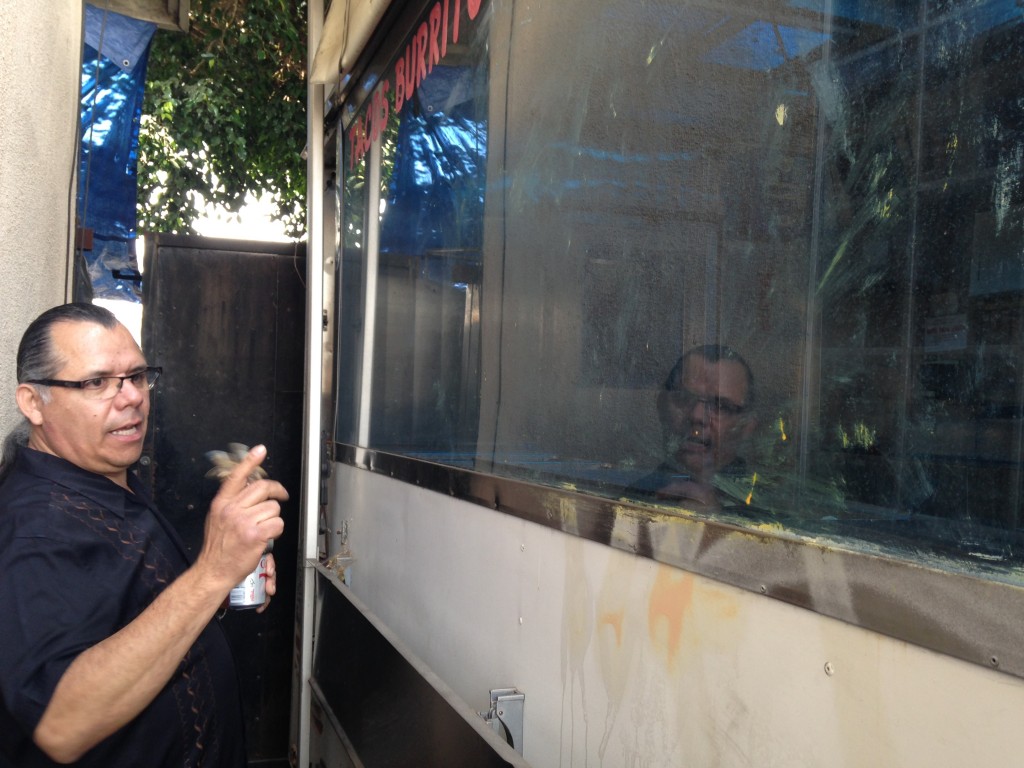
Enrique Diaz shows the truck-trailer where he once sold tacos after upgrading from a street table. He now operates a brick-and-mortar restaurant in South LA called La Carreta. | Daina Beth Solomon
Enrique Diaz, owner of La Carreta restaurant in South L.A., has mixed feelings. His first job in L.A. after emigrating from Mexico 30 years ago was selling tacos out of a truck. He moved on to other lines of work, but returned to tacos in 1993 when he set up a street stand in South L.A. Within a year he progressed to a taco-trailer, and by 1997 had built his own brick-and-mortar restaurant at Vernon and Compton avenues.
It continues to sell tacos along with burritos and other Mexican snacks – but it faces competition from many nearby street vendors selling nearly identical items.
“I never call police for illegal stands, because I started like that,” Diaz said. “But sometimes they set up half-a-block away. I pay a lot of taxes! It’s very hard to compete with them, because they have lower prices.”
Another concern is food safety. In the years of running La Carreta, said Diaz, he’s learned how to regulate cooking temperatures and comply with myriad other health department standards. “Other people don’t know nothing about what’s safe for customers,” he said.
Diaz said he’s skeptical that street food’s legalization will pass at all, simply due to the challenges of cooking outdoors without proper equipment.
However, street vending advocates consider the permitting systems in major cities such as New York and Portland to be proof that legalization will work. The details of proposed regulations for street vendors in Los Angeles have yet to be revealed.
No matter what the system entails, vendors hope the permit will be affordable, said Israel “El Peke” Villada, who sells steamed tacos each weekend at Mercado Olympic. Otherwise, he said, street sellers will likely continue working without one, preferring to risk the disruption that comes when the police or city enforcement teams show up.
As soon as the daily taco supply runs out, usually around 4 p.m., Villada can take off his salsa-stained apron and stop working. After hours of keeping his eye out for cops and city inspectors, Villada ambles through the Mercado Olympic in his jeans and hoodie like hundreds of other shoppers hunting down buttered corn on the cob and steak quesadillas. He is free, finally, from the fear of getting caught.
________________________________________________________________
View a slideshow of street cooks and foods in South LA:
Like Intersections on Facebook, follow us on Twitter and sign up for the Newsletter to stay in the loop on news and views from South LA. Email the author at [email protected] and follow her on Twitter at @dainabethcita.









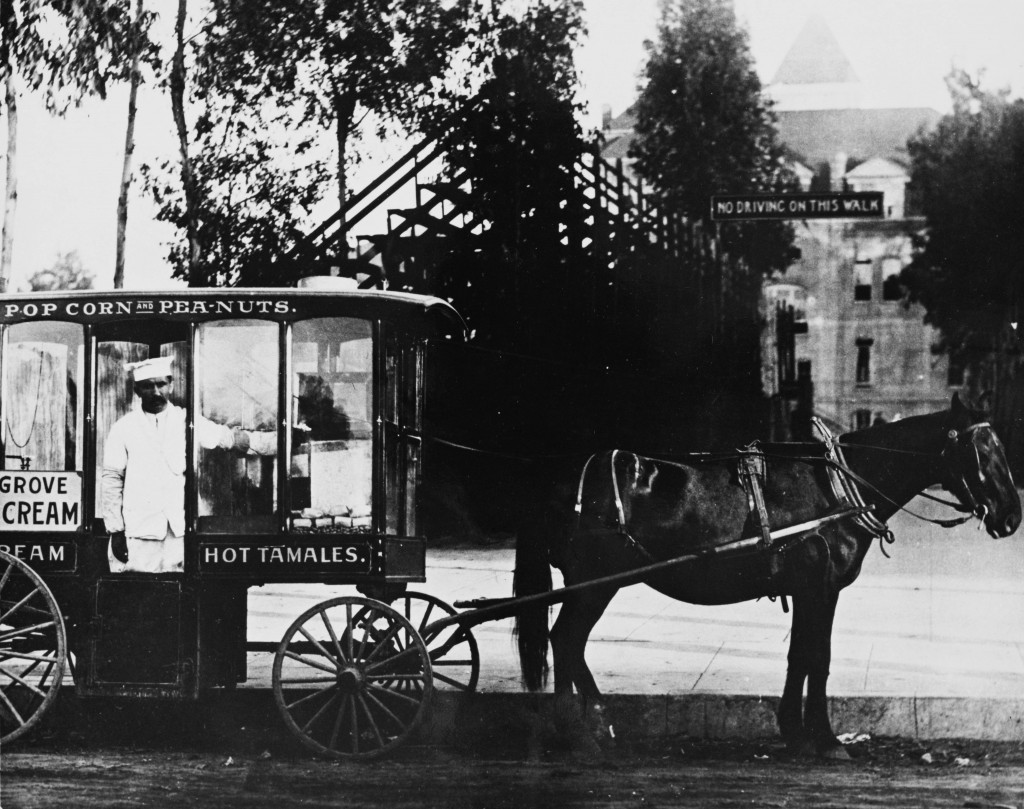






Speak Your Mind